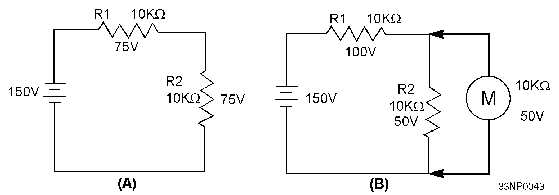3-16
center-zero- (0 reading is in the center) indicating instrument. Observing the correct polarity is important
when connecting the instrument to the circuit. Voltmeter polarity is the same as for the dc ammeter; that
is, current flows from negative to positive.
Q-17. In what manner are voltage-measuring instruments connected to the circuit to be measured?
Influence of a Voltmeter in a Circuit
The purpose of a voltmeter is to indicate the potential difference between two points in a circuit.
When a voltmeter is connected across a circuit, it shunts the circuit. If the voltmeter has a low resistance,
it will draw a substantial amount of current. This action lowers the effective resistance of the circuit and
changes the voltage reading. When you are making voltage measurements in high-resistance circuits, use
a HIGH-RESISTANCE VOLTMETER to prevent the shunting action of the voltmeter. The effect is less
noticeable in low-resistance circuits because the shunting effect is less. The problem of voltmeter
shunting (sometimes called circuit loading) is illustrated in figure 3-11.
Figure 3-11.—Shunting action caused by a voltmeter.
Q-18. When making voltage measurements in a high-resistance circuit, you should always use a
voltmeter with what relative value of resistance?
In view A of figure 3-11, a source of 150 volts is applied to a series circuit consisting of two 10-
kilohm resistors. View A shows the voltage drop across each resistor to be 75 volts. In the 150-volt range,
the voltmeter to be used has a total internal resistance of 10 kilohms. View B shows the voltmeter
connected across the circuit. The parallel combination of R2 and the meter now present a total resistance
of 5 kilohms. Because of the addition of the voltmeter, the voltage drops change to 100 volts across R1
and 50 volts across R2. Notice that this is not the normal voltage drop across R2. Actual circuit conditions
have been altered because of the voltmeter.
Voltmeter Sensitivity
The sensitivity of a voltmeter is given in ohms per volt. It is determined by dividing the sum of the
resistance of the meter (Rmeter), plus the series resistance (Rseries), by the full-scale reading in volts. In
equation form, sensitivity is expressed as follows:
This is the same as saying the sensitivity is equal to the reciprocal of the full-scale deflection current.
In equation form, this is expressed as follows:

